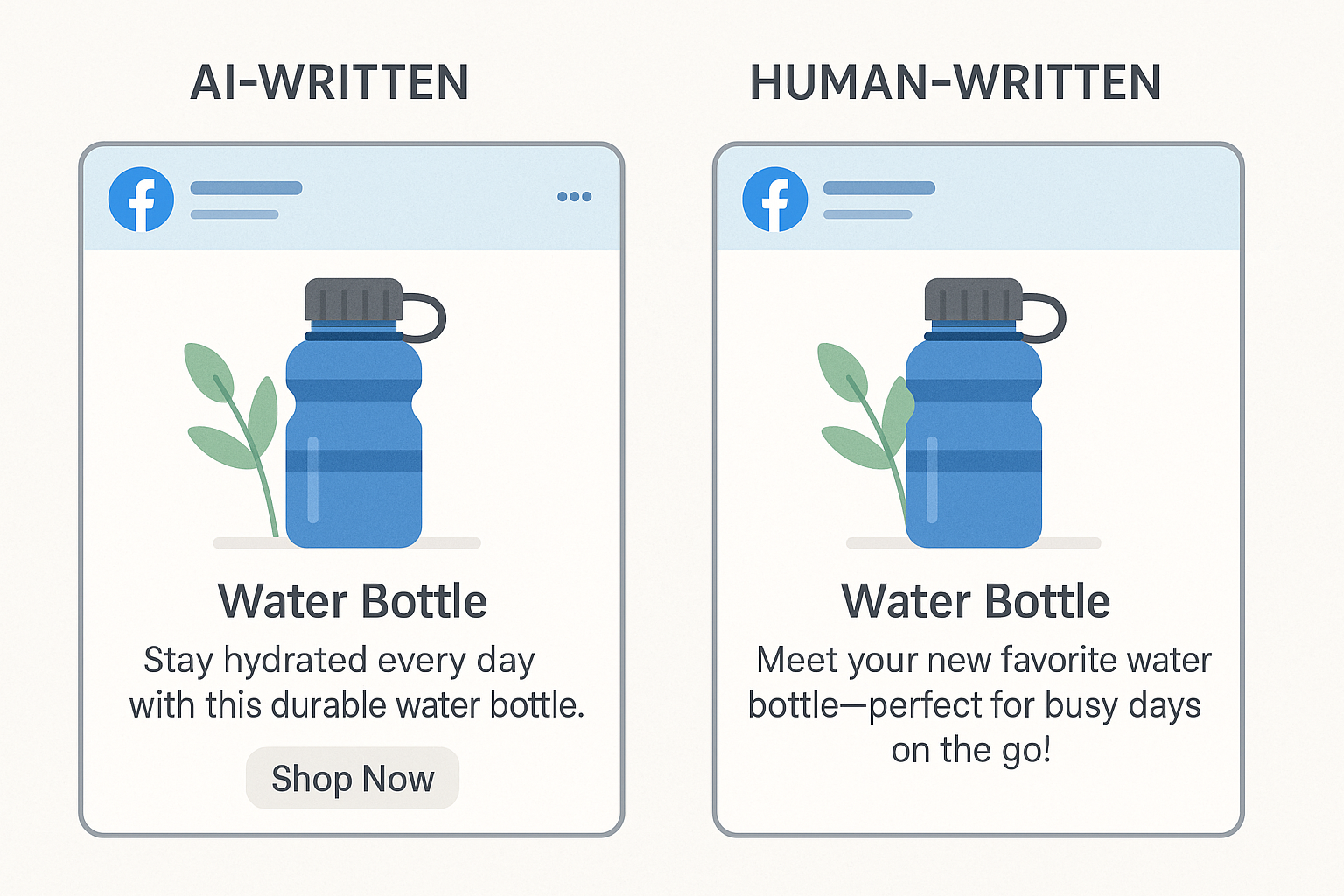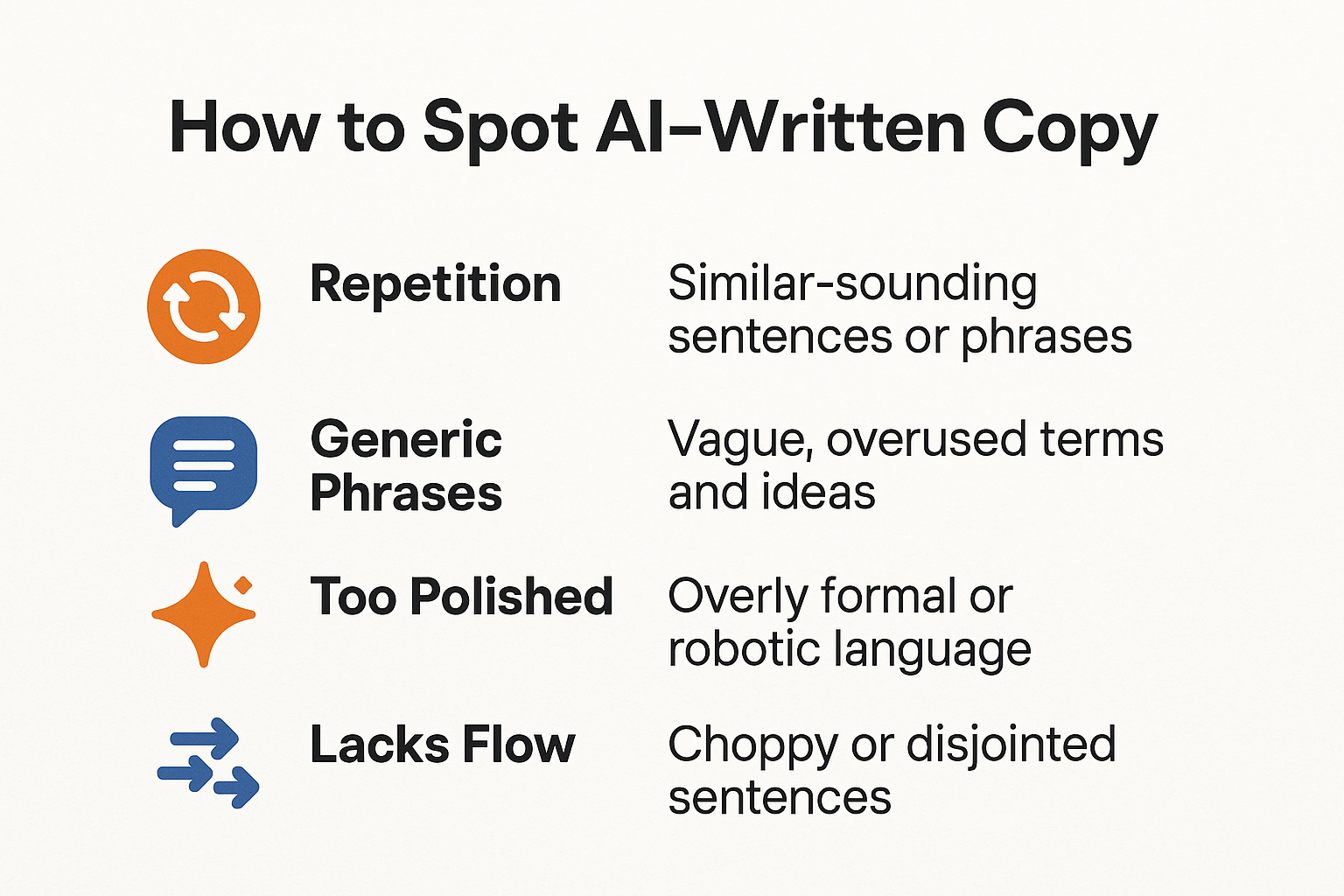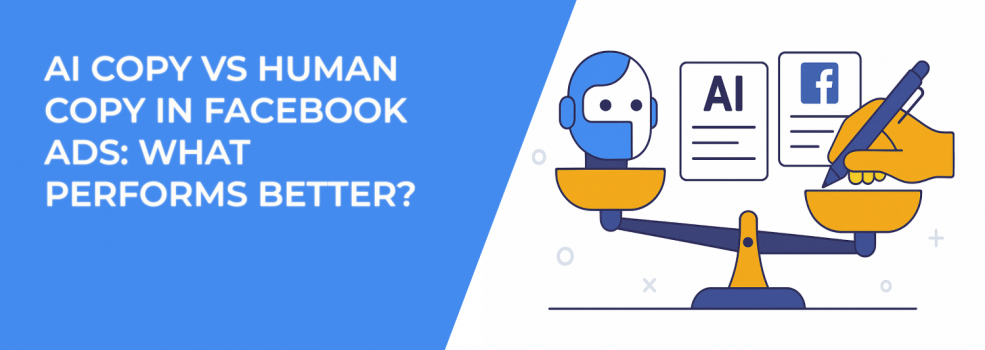Ad copy is one of the most important elements in a Facebook ad. Strong copy grabs attention, keeps people reading, and drives action. But the rise of AI tools has changed how businesses write ads.
Today, marketers face a new question:should you use AI-generated copy, or stick with content written by humans?
The truth is — you can often read an ad and not know who wrote it. AI has gotten that good. But if you look closely, there are still clues that reveal whether a copy came from a machine or a person. And when it comes to performance, those small differences can matter.
What Does AI Copy Look Like?
AI-generated copy is created using tools like ChatGPT, Jasper, or Copy.ai. These tools take a few inputs — like your product description or offer — and produce ready-to-use ad text.

Marketers often use AI to write:
-
Headlines for cold or warm audiences,
-
Primary ad text for feed ads or Reels,
-
Variations of the same copy for testing,
-
Short CTA prompts or benefit-driven blurbs.
For example, here’s how AI might promote a fitness app:
AI version:“Track your progress, stay on schedule, and hit your goals faster. Download the app now.”
And here’s how a human might write it:“Too tired to hit the gym? This app helps you build momentum on the days motivation’s missing — no guilt, no pressure.”
Both are clear. But the second one feels more real. It uses casual language and speaks directly to a common struggle.
Sometimes, it’s hard to tell which one was written by AI — especially if the tool has been fine-tuned. But often, you’ll notice a few telltale signs.
How to Tell If an Ad Was Written by AI
Even when AI-generated copy reads well, it often shows patterns that feel slightly off.

Some common signs include:
-
Repeating sentence structures across different ads,
-
Using overly broad phrases like “revolutionize your routine” or “take your results to the next level,”
-
Focusing on benefits without clearly addressing the problem,
-
Lacking personal tone, empathy, or specificity,
-
Including words or phrases that sound “nice,” but don’t mean much.
AI-generated content tends to feel polished, but sometimes too polished — like it came out of a template instead of a real person’s head.
Where AI Copy Shines
AI isn’t a replacement for experienced writers — but it does have practical uses. It can help you get started, move faster, or explore more creative angles. Here are some things AI is genuinely good at:
-
Speed — You can produce 10 versions of ad copy in minutes, not hours.
-
Volume — When testing multiple campaigns, AI can generate variations quickly.
-
Inspiration — Not sure where to start? AI tools can help break writer’s block.
-
Consistency — It’s easy to match tone across dozens of assets if needed.
If you want to explore high-quality tools, The Best AI Text and Image Generators is a good starting point.
Why Human Copy Often Performs Better
Even when AI sounds good, it doesn’t always feel good. Human-written ads often connect on a deeper level because they:
-
Use natural, everyday language instead of “marketing speak,”
-
Reflect a clear understanding of the audience’s mindset or problems,
-
Include emotion, subtle humor, or storytelling elements,
-
Speak to objections and real-life situations,
-
Sound like one person talking to another — not a script.
For example, a human-written ad for a bookkeeping service might say:
“If your books give you Sunday night anxiety, we should talk. Our team makes tax season feel a lot less stressful.”
It’s not flashy — but it’s clear, relatable, and honest.
To improve clarity and impact in your own ads, take a look at Crafting Compelling Facebook Ads Copy That Converts.
Pros and Cons of AI vs Human Ad Copy
Each approach has strengths and weaknesses.
AI-generated copy is useful when:
-
You need to test multiple variations quickly,
-
You’re promoting a straightforward offer or sale,
-
Your message is informational, not emotional,
-
You need to stay consistent across dozens of ads.
But AI can fall short when nuance is needed. It often avoids bold statements, doesn’t handle objections well, and lacks the clear, conversational style that makes ads truly resonate.
Human copywriting is more effective when:
-
Your product or service requires trust and explanation,
-
You want to show personality or brand voice,
-
Your goal is to create an emotional connection,
-
You’re targeting a skeptical or niche audience.
Human writers also tend to write more clearly. They remove clutter. They choose the right words — not just the expected ones. That’s hard for AI to do consistently.
Want to Know What Works? Test Both
You don’t have to guess. One of the best ways to understand what performs better is to test AI-generated copy against human-written versions. Here's a simple way to do it:
-
Write one version of your ad using AI.
-
Write another version manually — or ask a copywriter to help.
-
Keep everything else the same: image, targeting, and CTA.
-
Run both ads with equal budgets for at least five days.
-
Compare performance metrics: CTR, cost per result, and conversion rate.
To get better results, make sure your test focuses on one variable at a time — like tone, structure, or hook. This guide will help: The Benefits of Testing Facebook Ad Copy Variations for Better Performance.
Common Mistakes to Avoid (AI or Not)
It doesn’t matter who wrote your ad if the copy isn’t helping your performance. Here are a few mistakes to watch for:
-
Writing only about features — not what they do for the user,
-
Using too much hype or fluff,
-
Sounding robotic or overly formal,
-
Failing to match tone with your visuals,
-
Ignoring objections or questions real buyers might have.
If your ad is getting impressions but no conversions, your copy could be the problem. Why Your Ad Copy Might Be Hurting Lead Quality (And How to Fix It) explains how to spot those issues early.
The Bottom Line
Sometimes, AI copy performs well. Other times, it falls flat. The same goes for human copy. What really matters is how clearly the message speaks to your audience — and how effectively it drives them to take action.
So should you use AI or write your ads by hand?
Try both. Use AI to move fast, generate ideas, and test variations. Then refine the winners with your own insights, experience, and tone.
And remember: great ad copy doesn’t always sound clever, but it always sounds human (even when written by AI).

